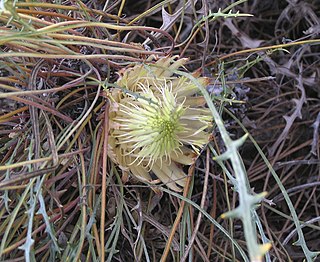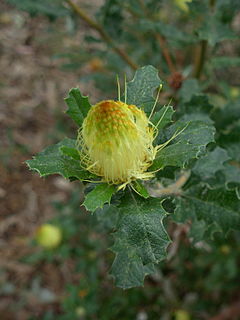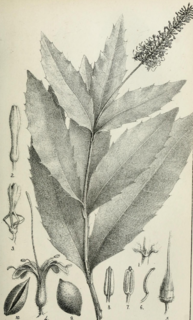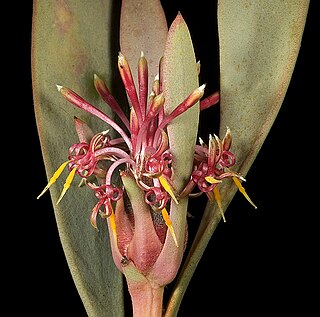
A standard-gauge railway is a railway with a track gauge of 1,435 mm. The standard gauge is also called Stephenson gauge after George Stephenson, International gauge, UIC gauge, uniform gauge, normal gauge and European gauge in Europe. It is the most widely used railway track gauge across the world, with approximately 55% of the lines in the world using it. All high-speed rail lines use standard gauge except those in Russia, Finland, Portugal and Uzbekistan. The distance between the inside edges of the rails is defined to be 1435 mm except in the United States and on some heritage British lines, where it is still defined in U.S. customary units as exactly "four feet eight and one half inches".

Banksia chamaephyton, commonly known as the fishbone banksia, is a species of shrub that is endemic to Western Australia. It has prostrate, underground stems, pinnatipartite leaves, cream-coloured and brown flowers arranged in spikes surrounded by hairy bracts. It grows in kwongan near the lower west coast.

Banksia gardneri, commonly known as prostrate banksia, is a species of prostrate shrub that is endemic to Western Australia. It has pinnatipartite or serrated leaves, usually rusty brown flowers, and up to twenty-five elliptical follicles in each fruiting head. It occurs along the west part of the south coast of the state.

Banksia lanata is a species of shrub that is endemic to a restricted area of Western Australia. It has linear leaves, pale cream-coloured flowers in a head with whitish bracts at the base and later up to fifty elliptical follicles in each head.

Banksia laricina, commonly known as the rose banksia, is a species of shrub that is endemic to southwestern Western Australia. It has crowded, linear leaves with a short point on the tip, golden brown flowers with a bright yellow style and prominent egg-shaped follicles.

Banksia occidentalis, commonly known as the red swamp banksia, is a species of shrub or small tree that is endemic to the south coast of Western Australia. It has smooth bark, linear, sparsely serrated leaves, golden flowers in a cylindrical spike, and later up to sixty follicles in each spike.

Banksia pilostylis is a species of shrub that is endemic to the south-west of Western Australia. It has hard, fissured bark, narrow wedge-shaped, serrated leaves, pale yellow flowers in cylindrical spikes and elliptical follicles that open when heated in a bushfire.

Banksia pulchella, commonly known as teasel banksia, is a species of small shrub that is endemic to the south-west of Western Australia. It has smooth grey bark, linear leaves and golden-brown flowers in short, cylindrical heads and inconspicuous follicles.

Banksia audax is a species of shrub that is endemic to Western Australia. It has fissured, grey bark, woolly stems, hairy, serrated leaves and golden orange flower spikes.

Banksia bipinnatifida is a is a species of shrub that is endemic to Western Australia. It is a prostrate shrub with a lignotuber, an underground stem, only a few divided leaves, large cream-coloured to pale yellow flowers and large fruit.
Banksia concinna is a species of shrub that is endemic to Western Australia. It has elliptical leaves with between five and twenty triangular teeth on each side, hairy heads of yellow flowers and hairy, egg-shaped fruit.
Banksia densa is a species of column-like shrub that is endemic to Western Australia. It has deeply serrated to pinnatifid leaves, creamy yellow flowers in heads of up to seventy-five, and hairy follicles.

Banksia rufa is a species of prostrate shrub that is endemic to the south-west of Western Australia. It has broadly linear, pinnatifid or pinnatipartite leaves with between five and twenty lobes on each side, yellow, orange or brownish flowers in heads of forty or more, and glabrous, egg-shaped follicles.
Banksia insulanemorecincta is a species of shrub that is endemic to a small region in the south-west of Western Australia. It is a bushy shrub with serrated, lance-shaped leaves with the narrower end towards the base, heads of about fifty cream-coloured and dull brown flowers and hairy, elliptical follicles.

Banksia undata, commonly known as urchin dryandra, is a species of shrub that is endemic to the southwest of Western Australia. It has sessile, wedge-shaped, wavy, serrated leaves, pale yellow flowers in heads of between 80 and 160, and later up to eight follicles in each head.

Banksia sclerophylla is a species of shrub that is endemic to the south-west of Western Australia. It has spreading stems, linear, pinnatipid leaves with triangular lobes on the sides, yellow flowers in heads of between forty and seventy, and elliptical follicles.

Hakea polyanthema is a shrub in the family Proteacea with small unpleasantly scented flowers in profusion in the leaf axils. It is endemic to Western Australia.

Hakea oldfieldii is a shrub of the family Proteaceae and is endemic to South West region of Western Australia. It has small white or cream-yellow flowers in profusion in spring.

Macadamia ternifolia is a tree in the flowering plant family Proteaceae, native to Queensland in Australia, and is listed as vulnerable under the EPBC Act.

Isopogon pruinosus is a shrub in the family Proteaceae that is endemic to southwestern Western Australia. There are two accepted subspecies:

















